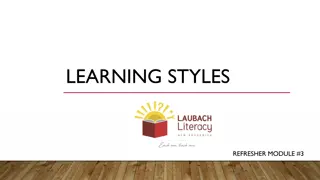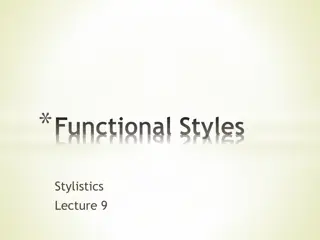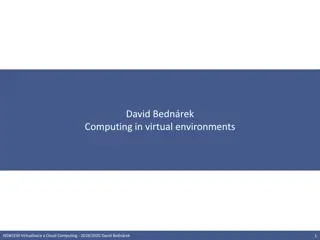Moldavian Architectural Styles Interactive Virtual Library Lesson Plan
Conceive a virtual library project where students explore Moldavian architectural styles through interactive maps, dialog boxes, hyperlinks, and quizzes. Groups create interactive portfolios based on gathered information to present and publish the best work. The teacher mentors and facilitates learning, while students engage in discussions, research, and improvement of their projects.
Download Presentation

Please find below an Image/Link to download the presentation.
The content on the website is provided AS IS for your information and personal use only. It may not be sold, licensed, or shared on other websites without obtaining consent from the author.If you encounter any issues during the download, it is possible that the publisher has removed the file from their server.
You are allowed to download the files provided on this website for personal or commercial use, subject to the condition that they are used lawfully. All files are the property of their respective owners.
The content on the website is provided AS IS for your information and personal use only. It may not be sold, licensed, or shared on other websites without obtaining consent from the author.
E N D
Presentation Transcript
MOLDAVIAN ARHITECTURAL STYLE -interactive map- ENACHE MIHAELA Religion 2 x 50 minutes 10th
The students will conceive a virtual library- gathering didactic materials- images, movies, gadgets, magazines, referring to the main architectural stiles identified in the Moldova region. Ihttp://www.romanianmonasteries.org/rom/images/geogra phy/bucovinamap.jpg Information about every monastery will be presented - under the form of: - dialog box; - hyperlinks; Helpful questions which lead to the obtaining of new information relay questions. The text boxes will be assisted by a virtual assistant, with the purpose of a guide. -. The students will be presented with images of the main architectural stiles, with which they will have to answer the fallowing questions: 1. What does an architectural stile mean? https://ro.wikipedia.org/wiki/Arhitectur%C4%83 2. Which are the main architectural stiles in Romania? How about Moldova? https://ro.wikipedia.org/wiki/Arhitectura_%C3%AEn_Mo ldova. There will take place discussions with an art teacher or, an architect will be invited. Using the gathered information students must create an interactive portfolio. Students arranged in 4 groups will present the projects using the fallowing steps - one group will present the project while the rest the groups will ask questions in witch the students chosen as representatives of the said will have to answer the fallowing work tasks: 1. they will have to select a landmark from the digital map; 2. they can request more information by opening text boxes, activating hyperlinks; 3. they will solve some puzzles/crossword puzzles; 4. they will answer some trap questions. Based on well established criteria (known at the start by the students) a selection of the best work will be made and it will be published in the schools magazine and site. Criteria: - title (must be representative); - correct drafting requirements; - esthetic requirements (the materials must be correct organized, page framing, the text and images must have a well-kept aspect) ; The groups of students: - will refer there activities to the examples of good practice (benchmarking best practices http://www.yourchildlearns.com/europe_map.htm - https://education.microsoft.com/ - https://moodle.org/) - exchanging information; - adding new things to the project, reorganizing the material; Every team brings improvements to their own project they add information, images, videos, sound traks. The teacher has the roll of a mentor, a facilitator of learning.
Description of lesson plan classDojo The teaching staff has the roll of facilitating the teaching approach using activities such as: - The creation of a teaching ambiance adequate space for the level and class specialization ( computers, internet access, tablets, chargers); - Compliance with the rules regarding work in the computer laboratory. 15 minutes 1stclas The teacher shows the students http://www.bing.com/videos/search?q=harta++interactiva+manastirilor+di n+bucovina+&&view=detail&mid=77632AE99ACC1275289D77632AE 99ACC1275289D&FORM=VRDGAR Discussions; What landmarks do you know in Bucovina? Through what objectives does this area of the country distinguishes itself? What monasteries do you know? Which were the ones that you memorized from the video clips? Internet - youtube 30 minutes 2st The didactic staff divides the class in 4 groups giving precise tasks 1. Every group must select a route 3 objectives - exemples : a) The Putna lui tefan route M n stirea Moldovi a, Sucevi a, Putna route; b) The Vorone Blue Vorone , Gura Humorului, Bucovina s Folk Museum; c) Moldova s capitalSuceava Dragomirna Monastery, Sf. Ioan Monastery, Moldova s Castle fortress d)The Neam monasteries Agapia, V ratic, Neam ului Padlet Teamup 40 minutes 1. 2. To select informative materials about everyone of them; To present the informative material under the shape of dialog boxes; questions, crossword puzzles, crosswords, puzzles; To realize the map on which it will attach images cu touristic attractions, processed information. 3. Socrative 15 minutes 3rd Presentation and evaluation of the products The selection Direct observation -Classroom activities -Interactions on a oral level - Behavior Formatives
Structuring a lesson plan 1. 2. 3. To identify the main touristic attractions in BUCOVINA; To correctly operate with the architectural stile terminologies, monastery; To discern a minimal of 3 differences between the byzantine, baroque an gothic stile. Monastery; Architectural stile; Baroque, gothic, byzantine; The project has the purpose to stimulate the student s ability to analyse and synthesis, in regards with the anterior and also with the attaining of new information; also in comparison with the work and effort of the other members. Socrative-TeamUp Kahoot- Tellagami-QR Codes- Classdojo- Google Drive -Platform- Edmodo/ INOVAR / Moodle-Padlet This project aims to determine a plus in value among the students ranks; also it has the purpose to stimulate the interest of the students to new research paths and scientific development. 1 creativity; 2 effective use and management of acquired information; 3 attractive project design; 4 it generates the capacities of evaluation and self evaluation; 5 Feedback management; 1 teamwork communication; 2 distribution of roles and tasks based on skills and acquired knowledge ; 3 presentation abilities; 4 time management; The students are the direct recipient of the educational act, as a result they are more creative, motivated, curious, competitiveness, open-minded.























